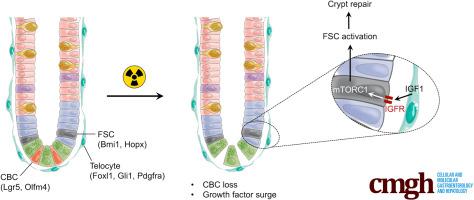Cellular and Molecular Gastroenterology and Hepatology ( IF 7.2 ) Pub Date : 2020-06-02 , DOI: 10.1016/j.jcmgh.2020.05.013 Natacha Bohin 1 , Kevin P McGowan 2 , Theresa M Keeley 2 , Elizabeth A Carlson 2 , Kelley S Yan 3 , Linda C Samuelson 1

|
Background & Aims
Intestinal crypts have a remarkable capacity to regenerate after injury from loss of crypt base columnar (CBC) stem cells. After injury, facultative stem cells (FSCs) are activated to replenish the epithelium and replace lost CBCs. Our aim was to assess the role of insulin-like growth factor-1 (IGF-1) to activate FSCs for crypt repair.
Methods
The intestinal regenerative response was measured after whole body 12-Gy γ-irradiation of adult mice. IGF-1 signaling or its downstream effector mammalian target of rapamycin complex 1 (mTORC1) was inhibited by administering BMS-754807 or rapamycin, respectively. Mice with inducible Rptor gene deletion were studied to test the role of mTORC1 signaling in the intestinal epithelium. FSC activation post-irradiation was measured by lineage tracing.
Results
We observed a coordinate increase in growth factor expression, including IGF-1, at 2 days post-irradiation, followed by a surge in mTORC1 activity during the regenerative phase of crypt repair at day 4. IGF-1 was localized to pericryptal mesenchymal cells, and IGF-1 receptor was broadly expressed in crypt progenitor cells. Inhibition of IGF-1 signaling via BMS-754807 treatment impaired crypt regeneration after 12-Gy irradiation, with no effect on homeostasis. Similarly, rapamycin inhibition of mTORC1 during the growth factor surge blunted the regenerative response. Analysis of Villin-CreERT2;Rptorfl/fl mice showed that epithelial mTORC1 signaling was essential for crypt regeneration. Lineage tracing from Bmi1-marked cells showed that rapamycin blocked FSC activation post-irradiation.
Conclusions
Our study shows that IGF-1 signaling through mTORC1 drives crypt regeneration. We propose that IGF-1 release from pericryptal cells stimulates mTORC1 in FSCs to regenerate lost CBCs.
中文翻译:

胰岛素样生长因子 1 和 mTORC1 信号促进辐射损伤后的肠道再生反应。
背景与目标
肠道隐窝在因隐窝基底柱状 (CBC) 干细胞丢失而受伤后具有显着的再生能力。损伤后,兼性干细胞 (FSC) 被激活以补充上皮细胞并替换丢失的 CBC。我们的目的是评估胰岛素样生长因子-1 (IGF-1) 在激活 FSC 以进行隐窝修复的作用。
方法
在成年小鼠全身 12-Gy γ-辐照后测量肠道再生反应。IGF-1 信号传导或其下游效应哺乳动物雷帕霉素复合物 1 (mTORC1) 靶标分别通过施用 BMS-754807 或雷帕霉素被抑制。对具有诱导性Rptor基因缺失的小鼠进行了研究,以测试 mTORC1 信号在肠上皮中的作用。通过谱系追踪测量辐照后的 FSC 激活。
结果
我们观察到生长因子表达的协调增加,包括 IGF-1,在照射后 2 天,随后在第 4 天隐窝修复的再生阶段期间 mTORC1 活性激增。IGF-1 定位于隐窝周围间充质细胞, IGF-1受体在隐窝祖细胞中广泛表达。通过 BMS-754807 处理抑制 IGF-1 信号会损害 12-Gy 照射后的隐窝再生,对体内平衡没有影响。类似地,在生长因子激增期间雷帕霉素对 mTORC1 的抑制减弱了再生反应。分析绒毛蛋白-CreER T2 ; Rptor FL / FL的小鼠表明,上皮mTORC1信号是为隐窝再生必要的。来自Bmi1 的谱系追踪-标记的细胞显示雷帕霉素在辐射后阻断了 FSC 活化。
结论
我们的研究表明 IGF-1 信号通过 mTORC1 驱动隐窝再生。我们建议从隐窝细胞释放的 IGF-1 会刺激 FSC 中的 mTORC1 以再生丢失的 CBC。



























 京公网安备 11010802027423号
京公网安备 11010802027423号